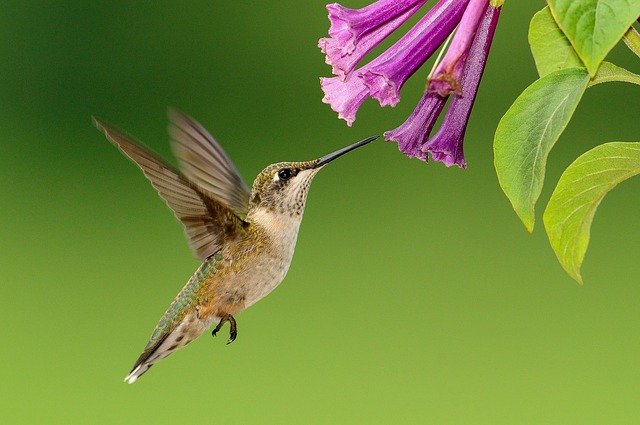How To Care For A Baby Hummingbird?
How to care for a baby hummingbird?
Hummingbirds, on average, usually live up to 4 years of life, if they exceed the first critical stages of their life.
(That is, the early months of life)
First of all, you have to know the feeding of a hummingbird
Baby hummingbird food. Hummingbirds and their long tongue allows them to suck the nectar from the flowers through the structure wound on the outside of the tongue. The flowers that are visited by hummingbirds are tubular, have abundant nectar and generally have a red, pink or orange hue – although hummingbirds visit flowers of all colors – Generally the flowers from which the hummingbird extracts its food does not offer a place to perch, they are hanging flowers, but that is no problem for them.
Hummingbirds are speedy animals; they can beat their wings up to 70 times per second by staying in the same place while extracting the nectar from the flower. Although hummingbirds feed mainly on the nectar of flowers, they complement their diet with small insects and spiders that they catch when they visit the flower. It is said that a hummingbird can visit 500 to 3000 flowers per day.
(THE RECOMMENDED IS TO TAKE THE HUMMINGBIRD TO AN EXPERT IN THE SUBJECT)
- Hummingbird babies need specialized first aid.
- These babies cannot regulate their body temperature and need to keep warm.
- Teenagers have down and can regulate their temperature better than newborns.
- Hummingbird babies and teenagers should not drink the homemade nectar that hummingbird adults can drink, because they need a high protein content in their food.
- It is correct to offer homemade nectar, but this will be useful at most four (4) hours; After that, if they do not eat protein, they can become severely crippled or die.
- If possible, do not try to feed a hummingbird baby, take it with a trained professional immediately.
- If you are more than four hours away from a professional wildlife rehabilitator or a veterinarian who is familiar with hummingbirds, consider having the product “Nektar-Plus” on hand (see the warning below), if you can find it .
How to prepare food for hummingbird
* Keep in mind that what this article says about “How to feed a hummingbird” explains it in a way that is as natural as possible, that is, the hummingbird comes and feeds only on its own,
When we find a baby hummingbird, it is difficult for him to eat alone, and therefore we will have to supply him with food through a syringe.
It is advisable to do what this person does in the video * “Disguise” the syringe, as if it were a flower, so you will get used to how you should eat naturally, without anyone’s help.
When some people see hummingbird babies alone in the nest, they believe that the mother abandoned her young. Generally, not the case. The mother can be perched on a tree or nearby bush waiting for the field to be “free” to go to her nest. However, if you believe that the chicks were abandoned, sit at a safe distance and observe the nest continuously for an hour. Mothers usually go to the nest to feed their children four to six (4 and 6) times in an hour. It is so fast (about four (4) seconds) that just by blinking, you might not see it.
* In general, hummingbird babies remain very quiet, so that predators do not know their location. If you hear a hummingbird baby chirps for more than ten (10) minutes, it is most likely that he is starving and needs immediate help.
If you find a hummingbird baby that fell from the nest, first check that the nest has not been invaded by ants or other insects that might have attacked it. * If the nest is safe, carefully take the small hummingbird from the torso (the body) and place it back in the nest. Hummingbirds have no sense of smell, so do not worry; the hummingbird mother will return to the nest because she will not detect the smell of humans. Sit at a safe distance and wait for the return of the hummingbird mom for at least an hour.
* If the nest is in danger, place the young in a small box or basket in a safe place near the original position of the nest. Be on your guard for another hour to see if the hummingbird mom finds her baby in the new location. If the mother does not return, see if the chick opens its beak looking for food. If you do, very carefully pour three (3) drops (or five (5) drops if you already have feathers) of sugar water (homemade nectar, 4: 1 solution) in your mouth.
- Offer the sugar-water solution every thirty (30) minutes until you get help.
- Get help as soon as you can to prevent the chick from being crippled or dying.
Warning about “Nektar-Plus” Nektar-Plus is an excellent nutritional supplement for hummingbirds. It is produced in Germany and is used commercially in aviaries and zoos around the world because it provides balanced nutrition and the right amount of protein. However: It should NOT be used in outdoor feeders for hummingbirds.
* Wild hummingbirds live well catching their own insects and do not need to learn to depend on a feeder. * It is costly* The expiration date on the bottle indicates that it expires shortly after buying it. * It must be replaced in the feeder twice a day because it decomposes quickly. * Always be used in sterilized feeders.
* It is difficult to obtain and is only available to licensed individuals.

